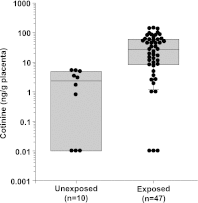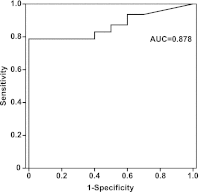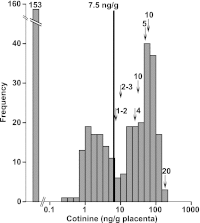Cotinine in human placenta predicts induction of gene expression in fetal tissues
- PMID: 23209192
- PMCID: PMC3558855
- DOI: 10.1124/dmd.112.049999
Cotinine in human placenta predicts induction of gene expression in fetal tissues
Abstract
Maternal cigarette smoking during pregnancy is associated with increased risk of perinatal morbidity and mortality. However, the mechanisms underlying adverse birth outcomes following prenatal exposure to cigarette smoke remain unknown due, in part, to the absence or unreliability of information regarding maternal cigarette smoke exposure during pregnancy. Our goal was to determine if placental cotinine could be a reliable biomarker of fetal cigarette smoke exposure during pregnancy. Cotinine levels were determined in placentas from 47 women who reported smoking during pregnancy and from 10 women who denied cigarette smoke exposure. Cotinine levels were significantly higher in placentas from women reporting cigarette smoking (median = 27.2 ng/g) versus women who reported no smoke exposure (2.3 ng/g, P < 0.001). Receiver operating characteristic curve analysis identified an optimal cut point of 7.5 ng/g (sensitivity = 78.7%, specificity = 100%) to classify placenta samples from mothers who smoked versus those from mothers who did not. Among 415 placentas for which maternal cigarette smoking status was unavailable, 167 had cotinine levels > 7.5 ng/g and would be considered positive for cigarette smoke exposure. Data from quantitative reverse-transcription polymerase chain reaction analyses demonstrated that in utero cigarette smoke exposure predicted by cotinine in placenta is associated with changes in the expression of xenobiotic-metabolizing enzymes in fetal tissues. CYP1A1 mRNA in fetal lung and liver tissue and CYP1B1 mRNA in fetal lung tissue were significantly induced when cotinine was detected in placenta. These findings indicate that cotinine in placenta is a reliable biomarker for fetal exposure and response to maternal cigarette smoking during pregnancy.
Figures





Comment in
-
Drug metabolism and transport during pregnancy: how does drug disposition change during pregnancy and what are the mechanisms that cause such changes?Drug Metab Dispos. 2013 Feb;41(2):256-62. doi: 10.1124/dmd.112.050245. Drug Metab Dispos. 2013. PMID: 23328895 Free PMC article.
Similar articles
-
Tobacco smoke-dependent changes in cytochrome P450 1A1, 1A2, and 2E1 protein expressions in fetuses, newborns, pregnant rats, and human placenta.Arch Toxicol. 2005 Jan;79(1):13-24. doi: 10.1007/s00204-004-0607-7. Epub 2004 Sep 23. Arch Toxicol. 2005. PMID: 15448981
-
Early pregnancy intrauterine fetal exposure to maternal smoking and impact on fetal telomere length.Eur J Obstet Gynecol Reprod Biol. 2017 Nov;218:27-32. doi: 10.1016/j.ejogrb.2017.09.013. Epub 2017 Sep 14. Eur J Obstet Gynecol Reprod Biol. 2017. PMID: 28926727
-
Induction of Cyp1a1 and Cyp1b1 and formation of DNA adducts in C57BL/6, Balb/c, and F1 mice following in utero exposure to 3-methylcholanthrene.Toxicol Appl Pharmacol. 2005 Nov 15;209(1):28-38. doi: 10.1016/j.taap.2005.03.012. Toxicol Appl Pharmacol. 2005. PMID: 15885734
-
Xenobiotic-metabolizing cytochrome P450 enzymes in the human feto-placental unit: role in intrauterine toxicity.Crit Rev Toxicol. 1998 Jan;28(1):35-72. doi: 10.1080/10408449891344173. Crit Rev Toxicol. 1998. PMID: 9493761 Review.
-
Long-term consequences of fetal and neonatal nicotine exposure: a critical review.Toxicol Sci. 2010 Aug;116(2):364-74. doi: 10.1093/toxsci/kfq103. Epub 2010 Apr 2. Toxicol Sci. 2010. PMID: 20363831 Free PMC article. Review.
Cited by
-
Embryonic Nicotine Exposure Disrupts Adult Social Behavior and Craniofacial Development in Zebrafish.Toxics. 2022 Oct 15;10(10):612. doi: 10.3390/toxics10100612. Toxics. 2022. PMID: 36287892 Free PMC article.
-
Age, Sexual Dimorphism, and Disease Associations in the Developing Human Fetal Lung Transcriptome.Am J Respir Cell Mol Biol. 2016 Jun;54(6):814-21. doi: 10.1165/rcmb.2015-0326OC. Am J Respir Cell Mol Biol. 2016. PMID: 26584061 Free PMC article.
-
DNA methylation perturbations may link altered development and aging in the lung.Aging (Albany NY). 2021 Jan 19;13(2):1742-1764. doi: 10.18632/aging.202544. Epub 2021 Jan 19. Aging (Albany NY). 2021. PMID: 33468710 Free PMC article.
-
Fetal lung and placental methylation is associated with in utero nicotine exposure.Epigenetics. 2014 Nov;9(11):1473-84. doi: 10.4161/15592294.2014.971593. Epigenetics. 2014. PMID: 25482056 Free PMC article.
-
Intrauterine Smoke Exposure, microRNA Expression during Human Lung Development, and Childhood Asthma.Int J Mol Sci. 2023 Apr 23;24(9):7727. doi: 10.3390/ijms24097727. Int J Mol Sci. 2023. PMID: 37175432 Free PMC article.
References
-
- Baheiraei A, Banihosseini SZ, Heshmat R, Mota A, Mohsenifar A. (2012) Association of self-reported passive smoking in pregnant women with cotinine level of maternal urine and umbilical cord blood at delivery. Paediatr Perinat Epidemiol 26:70–76 - PubMed
-
- Benowitz NL, Bernert JT, Caraballo RS, Holiday DB, Wang J. (2009a) Optimal serum cotinine levels for distinguishing cigarette smokers and nonsmokers within different racial/ethnic groups in the United States between 1999 and 2004. Am J Epidemiol 169:236–248 - PubMed
-
- Berlin I, Heilbronner C, Georgieu S, Meier C, Spreux-Varoquaux O. (2010) Newborns’ cord blood plasma cotinine concentrations are similar to that of their delivering smoking mothers. Drug Alcohol Depend 107:250–252 - PubMed
Publication types
MeSH terms
Substances
Grants and funding
LinkOut - more resources
Full Text Sources

